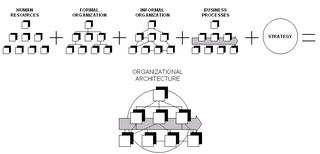Related Research Articles
A performance appraisal, also referred to as a performance review, performance evaluation, (career) development discussion, or employee appraisal, sometimes shortened to "PA", is a periodic and systematic process whereby the job performance of an employee is documented and evaluated. This is done after employees are trained about work and settle into their jobs. Performance appraisals are a part of career development and consist of regular reviews of employee performance within organizations.
Micromanagement is a management style characterized by such behaviors as an excessive focus on observing and controlling subordinates and obsession with details.
Middle management is the intermediate management level of a hierarchical organization that is subordinate to the executive management and responsible for "team leading" line managers and/or "specialist" line managers. Middle management is indirectly responsible for junior staff performance and productivity.
Team management is the ability of an individual or an organization to administer and coordinate a group of individuals to perform a task. Team management involves teamwork, communication, objective setting and performance appraisals. Moreover, team management is the capability to identify problems and resolve conflicts within a team. Teams are a popular approach to many business challenges. They can produce innovative solutions to complex problems. There are various methods and leadership styles a team manager can take to increase personnel productivity and build an effective team. In the workplace teams can come in many shapes and sizes who all work together and depend on one another. They communicate and all strive to accomplish a specific goal. Management teams are a type of team that performs duties such as managing and advising other employees and teams that work with them. Whereas work, parallel, and project teams hold the responsibility of direct accomplishment of a goal, management teams are responsible for providing general direction and assistance to those teams.

Centralisation or centralization is the process by which the activities of an entity or organization, particularly those regarding planning, decision-making and control of strategies and policies, become concentrated within a particular group, sector, department or region within that entity or organization. This creates a power structure where the said group, known as head or core group, occupies the highest level of hierarchy and has significantly more authority, prestige and influence over the other groups, who are considered its subordinates.

The principal–agent problem refers to the conflict in interests and priorities that arises when one person or entity takes actions on behalf of another person or entity. The problem worsens when there is a greater discrepancy of interests and information between the principal and agent, as well as when the principal lacks the means to punish the agent. The deviation from the principal's interest by the agent is called "agency costs".
Span of control, also called span of management, is a term used in business management, particularly human resource management. The term refers to the number of subordinates or direct reports a supervisor is responsible for.

A supervisor, or lead, is the job title of a lower-level management position that is primarily based on authority over workers or a workplace. A supervisor can also be one of the most senior on the staff at the place of work, such as a professor who oversees a Ph.D. dissertation. Supervision, on the other hand, can be performed by people without this formal title, for example by parents. The term supervisor itself can be used to refer to any personnel who have this task as part of their job description.

Organizational architecture, also known as organizational design, is a field concerned with the creation of roles, processes, and formal reporting relationships in an organization. It refers to architecture metaphorically, as a structure which fleshes out the organizations. The various features of a business's organizational architecture has to be internally consistent in strategy, architecture and competitive environment.
Organizing or organising is the establishment of effective authority-relationships among selected works, which often improves efficiency.
Management consists of the planning, prioritizing, and organizing work efforts to accomplish objectives within a business organization. A management style is the particular way managers go about accomplishing these objectives. It encompasses the way they make decisions, how they plan and organize work, and how they exercise authority.
Office administration is a set of day-to-day activities that are related to the maintenance of an office building, financial planning, record keeping and billing, personal development, physical distribution and logistics, within an organization. An employee that undertakes these activities is commonly called an office administrator or office manager, and plays a key role in any organization's infrastructure, regardless of the scale. Many administrative positions require the candidate to have an advanced skill set in the software applications Microsoft Word, Excel and Access.
Project governance is the management framework within which project decisions are made. Project governance is a critical element of any project, since the accountabilities and responsibilities associated with an organization's business as usual activities are laid down in their organizational governance arrangements; seldom does an equivalent framework exist to govern the development of its capital investments (projects). For instance, the organization chart provides a good indication of who in the organization is responsible for any particular operational activity the organization conducts. But unless an organization has specifically developed a project governance policy, no such chart is likely to exist for project development activity.
A functional manager is a person who has management authority over an organizational unit—such as a department—within a business, company, or other organization. Functional managers have ongoing responsibilities, and are not usually directly affiliated with project teams, other than ensuring that goals and objectives align with the organization's overall strategy and vision.
POSDCORB is an acronym widely used in the field of management and public administration that reflects the classic view of organizational theory. It appeared most prominently in a 1937 paper by Luther Gulick. However, he first presented the concept in 1935. Initially, POSDCORB was envisioned in an effort to develop public service professionals. In Gulick's own words, the elements are as follows: Planning, Organizing, Staffing, Directing, Co-Ordinating, Reporting and Budgeting.

A working group, is a group of experts working together to achieve specified goals. The groups are domain-specific and focus on discussion or activity around a specific subject area. The term can sometimes refer to an interdisciplinary collaboration of researchers working on new activities that would be difficult to sustain under traditional funding mechanisms.

Fayolism was a theory of management that analyzed and synthesized the role of management in organizations, developed around 1900 by the French manager and management theorist Henri Fayol (1841–1925). It was through Fayol's work as a philosopher of administration that he contributed most widely to the theory and practice of organizational management.He is know as the father of general management.
Reward management is concerned with the formulation and implementation of strategies and policies that aim to reward people fairly, equitably and consistently in accordance with their value to the organization.
Managing Up and Managing Down is a part of management that details how middle managers or supervisors should effectively deal with their managers and subordinates. Promotion to management comes with additional responsibility of managing down. With the additional responsibility for managing their team while remaining accountable to their management teams, managers require additional skills and training to effectively influence up or down. Management levels within large organizations are structured from a hierarchal organization and include senior, middle, and lower management roles.
MS 1722:2011 – Occupational Safety and Health Management Systems – Requirements is a Malaysian Standard that provides requirements on Occupational Safety and Health Management Systems (OSHMS) and basis for the development OSH systems in an organisation. The MS 1722 standard enable an organization to manage its OHS risks and improve its OHS performance. The requirements of the standard are intended to address OHS for employees, temporary employees, contractors and other personnel on site rather than the safety of products and services. The standards provide a more effective method of protecting employees and others from workplace injuries and illnesses and demonstrate management commitment in meeting OHS requirements.
References
- 1 2 Schermerhorn, J., Davidson, P., Poole, D., Woods, P., Simon, A., & McBarron, E. (2017). Management (6th ed., pp. 282–286). Brisbane: John Wiley & Sons Australia.
- 1 2 Meagher, Kieron J; Wait, Andrew (11 April 2021). "Worker Trust in Management and Delegation in Organizations". The Journal of Law, Economics, and Organization. 36 (3): 495–536. doi:10.1093/jleo/ewaa008.
- ↑ Portny, Stanley E. (2017). Project Management For Dummies. John Wiley & Sons. ISBN 978-1-119-34889-4.[ page needed ]
- 1 2 3 4 5 6 7 8 9 10 G. Banford, Christopher; Ronald Buckley, M.; Roberts, Foster (30 September 2014). "Delegation revisited: how delegation can benefit globally-minded managers". International Journal of Physical Distribution & Logistics Management. 44 (8/9): 646–654. doi:10.1108/ijpdlm-07-2013-0191.
- 1 2 3 4 5 6 7 8 9 10 11 12 13 14 15 Treher, E., Piltz, D., & Jacobs, S. (2011). Increasing effectiveness through delegation. In A Guide to Success for Technical Managers: Supervising in Research, Development, & Engineering (pp. 89–111). John Wiley & Sons, Inc.
- ↑ Smith, Cassandra C. (2012). Recognizing the Need For, Impacts and Benefits of Effective Delegation In the Work Place (Thesis). DTIC ADA558768.
- 1 2 3 4 5 6 7 8 9 10 Rani, S., Renugadevi, C., Ravindran, N., Kuppusamy. (2018). Office Management and Secretaryship 12th Std. Tamil Nadu: Department of School Education
- 1 2 3 4 5 6 7 8 9 Marvin, Stephen (2010). Dictionary of Scientific Principles. doi:10.1002/9781118582121. ISBN 978-1-118-58212-1.[ page needed ]